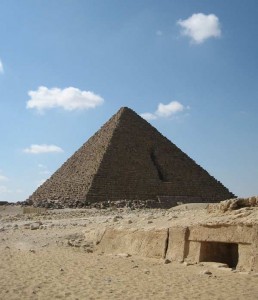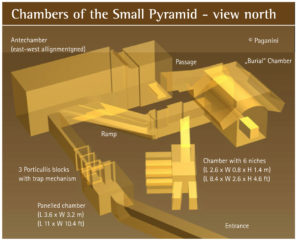“Mykerinos” Pyramid
The Small Pyramid
While it is the smallest of the 3 Giza Pyramids, at nearly 60 m / 197 ft tall, the “Mykerinos” Pyramid may be less than half as high as the “Cheops” Pyramid, but is in no way less significant. Though its base length is just over 100 m / 328 ft, when viewed on its own, the “Mykerinos” Pyramid is just as impressive and grand as the other two. Its construction is based on the same technical skills. The earliest mention of the “Mykerinos” Pyramid was recorded by Herodotus (ca. 484 to 425 B.C.).
The lower third of the “Mykerinos” Pyramid is encased with pink granite and the rest with lighter colored Tura limestone. There remain 16 layers of granite casing stones at the base of the pyramid. The looting troops of Caliph Othman were thus forced to climb over this granite encasing to reach the limestone blocks.* The passage leading beneath the pyramid (which is quite narrow and low, forcing one to stoop in order to enter) is also partly made of this same reddish-brown granite.
Underground chambers
This passageway ends after 31 meters / 102 feet in a nearly square-shape paneled chamber, measuring 3.6 x 3.16 m / 11.81 x 10.37 ft, which is also made of the same pink granite. The passage continues on the other side of this chamber and after 12 m / 39.4 ft leads to the Antechamber, which measures 14.2 m / 46.6 ft long (east-west orientation) and 3.9 m / 12.6 ft wide and 4.9 m / 16 ft high. Three additional passages branch off at this point: from the northern wall, a longer blind shaft extends up into the pyramid complex. A ramp leads down through the floor into a small antechamber with four niches and then straight ahead lays the Burial Chamber, featuring a beveled ceiling. The third hallway, which leads from the western wall of the Antechamber, is called the Passage. It leads to the ceiling area above the Burial Chamber.
This is an excerpt from the book GIZA LEGACY.





